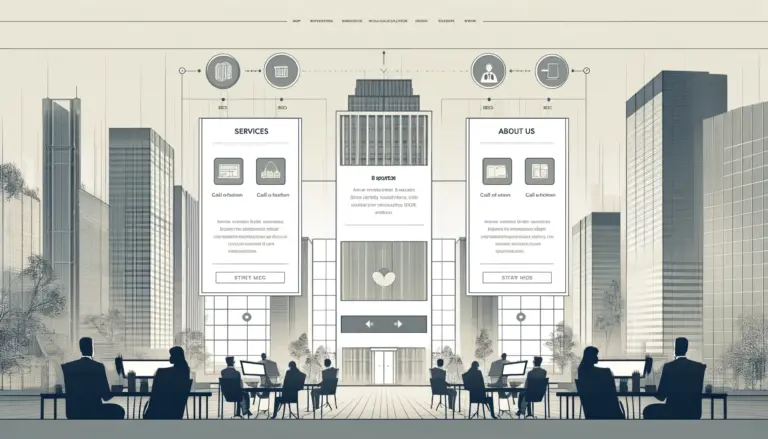Websites age just like technology and user expectations. To stay relevant and provide a positive user experience, it is crucial to regularly refresh your website. Here are the top 10 signs that it’s time to refresh your Web site.
Maintaining your website is similar to maintaining your car. Regular maintenance ensures that performance remains optimal and prevents bigger problems in the future. A website that is not properly maintained, like a car, can eventually stall.
1. Difficult Navigation
A Web site should help visitors find the information they need quickly and easily. If your Web site is difficult to navigate, visitors may become frustrated and leave your site. This can lead to a high bounce rate and less time users spend on your site. Visitors want to quickly find the information they are looking for without too many clicks. So clear and simple navigation is crucial for a good user experience.
Difficult navigation can have a negative impact on your website because visitors find it difficult to find what they need. This can lead to a high bounce rate, which means people leave your Web site quickly. If visitors become frustrated, they are less likely to return to your site. This can also result in lower customer satisfaction and fewer conversions. A poorly organized Web site can undermine your credibility and professional image.
Common problems:
- A cluttered layout
- Too many menu options
- A website structure that focuses more on your organization than the needs of users
- Poorly labeled links
- Excessive use of technical terms and acronyms
- Dead links
Solutions:
- Simplify the layout: Remove unnecessary elements and make sure the most important information is prioritized.
- Restructure your menus: Make popular pages easily findable in the main menu.
- Use clear labels: Avoid vague terms, acronyms and jargon.
- Provide responsive menus: Make sure your navigation is easy to use on mobile devices.
2. Too Much and Difficult to Understand Content.
Excessive and complicated content can put visitors off. Users want to be able to find relevant information quickly without having to slog through a wall of text. Short, clear and well-organized information is essential to hold the user’s attention. Using visual elements such as images and infographics can help make content more appealing. It is important to review and update content regularly to ensure it remains relevant and understandable.
Too much and difficult to understand content can cause visitors to become overwhelmed and leave your site. This can lead to a high bounce rate and low engagement. If users cannot find what they are looking for quickly, they will go to another site where the information is easier to understand. This can also negatively impact your SEO, as search engines prefer clear and relevant content. Ultimately, this can result in a decrease in visitors and conversions.
Common problems:
- Visitors are not sure if they are in the right place
- It seems too much work to understand the information
- Users may find a more convenient experience elsewhere
Solutions:
- Distribute content: Use short sentences, paragraphs and sections. Use lists and clear headings for scannable content.
- Add visuals: Images help users absorb information and provide a welcome change from text.
- Focus on quality over quantity: Create and refine a few key content pieces rather than lots of long text to persuade users.
3. Lack of Clear Calls to Action (CTAs).
A call to action (CTA) is anything that prompts the user to take a specific action. Clear and eye-catching CTAs are essential to guide users to desired actions, such as making a purchase or signing up for a newsletter. An effective CTA should be highly visible and tell the user exactly what is expected of them. Using actionable language can increase the effectiveness of your CTAs. It is also important to place CTAs consistently on your Web site so users know where to find them.
Lack of clear CTAs can result in users not knowing what to do on your Web site. This can result in lower conversions because visitors are not prompted to take action. Hidden or unclear CTAs can also cause confusion, causing users to leave the site without taking the desired action. Too many CTAs on a page can be overwhelming and lead to user indecision. This can ultimately reduce the effectiveness of your website and negatively affect the overall user experience.
Common problems:
- Hidden CTAs that users miss
- Unclear wording
- Too many CTAs on a page
Solutions:
- Prioritize: Determine which CTAs are most relevant to each section or page.
- Consistency: Make sure CTAs are styled and positioned the same way from page to page.
- Powerful lyrics: Use concise, action-oriented language such as “Sign up” instead of “Sign up.”
4. Outdated or Inaccurate Content.
Content is one of the most important aspects of a Web site. Updating your content regularly ensures that your information remains current, relevant and reliable. Outdated or inaccurate information can damage your credibility and drive visitors away. It is important to have a consistent content management plan to ensure that all information on your site is up-to-date. This includes checking links, updating statistics and removing outdated content.
Outdated or inaccurate content can lead to confusion and distrust among your visitors. If users discover that the information on your site is inaccurate, they may decide to stop using your services. This can also negatively impact your SEO, as search engines prefer up-to-date and relevant content. Outdated content can make your site less attractive and deteriorate the user experience. Ultimately, this can result in a decrease in visitors and reduced customer satisfaction.
Common problems:
- Incorrect information (for example, a phone number missing a digit)
- Low-quality content that does not meet brand or content guidelines
- Obsolete statistics, addresses or data
- Broken links
Solutions:
- Content audit: Identify content that needs to be updated, removed, merged or enhanced.
- Consulting content experts: Make sure the information is accurate, especially for technical or niche information.
- Content governance plan: Establish a plan for updating content and assign responsibilities.
5. Irrelevant Search Results
Users expect the search function on your Web site to help them find relevant information quickly. If the search results on your site are not relevant, users may become frustrated and leave your site. It is important to ensure that your search function is properly configured and regularly updated. This includes indexing all relevant content and using clear and accurate tags and categories. A well-functioning search function can significantly improve the user experience.
Irrelevant search results can seriously damage the user experience. If users cannot find what they are looking for, they are likely to leave your site and go to another source. This can lead to a high bounce rate and low engagement. Irrelevant search results can also undermine your credibility and discourage users from returning to your site. This can ultimately result in a decrease in visitors and conversions. So it is essential to optimize and update your search function regularly.
Common problems:
- Poor prioritization – the most relevant content does not appear at the top
- Incomplete search results – some content is not indexed
Solutions:
- Test the search interface: Use realistic searches to see if the most important content appears at the top.
- Review tags and categories: Make sure they are complete and applied to all relevant content.
- Refresh the search index regularly.
6. Slow Load Times
The longer it takes for a Web page to load, the more likely people are to leave your Web site. Fast load times are crucial for good users and can improve conversion rates. Optimize images and use a content delivery network (CDN) to make your site faster. Minimizing HTTP requests and upgrading your hosting can also help reduce load times. A fast Web site keeps visitors on your site longer and increases the likelihood of conversions.
Slow load times can lead to a high bounce rate and less time spent by users on your site. This can seriously harm the user experience and discourage visitors from returning to your site. Slow websites can also negatively impact your SEO because search engines prefer fast-loading sites. This can ultimately result in a decrease in visitors and conversions. So it is essential to regularly test and optimize the speed of your website.
Common problems:
- Large media such as images and videos that are not optimized
- Wrong hosting – a hosting service that does not have enough capacity
Solutions:
- Optimize images: Make sure images are optimized for the Web.
- Use a content delivery network (CDN): This helps deliver your website content faster by caching it closer to the user.
- Upgrade your hosting: Choose a hosting provider that offers fast and secure services.
7. Dependence on Developers for Any Change.
A major advantage of a CMS-based Web site is the ability to quickly and easily update content yourself. If you depend on developers for every small change, this can be costly and time-consuming. An intuitive CMS allows you to easily manage content without technical knowledge. This allows you to respond quickly to changing business needs and market trends. Regularly updating your CMS can also improve the overall performance and security of your website.
Dependence on developers for every change can lead to higher costs and longer wait times. This can limit the flexibility of your Web site and cause content to become obsolete. Additional pressure on developers can also mean delaying important security updates and new features. This can negatively affect the overall user experience and lead to a decrease in visitors and conversions. So it is important to invest in a user-friendly CMS and make regular updates.
Common problems:
- Higher costs and wait times
- Additional pressure on developers, reducing attention to new features or security
- Neglected content because changes are difficult to make
Solutions:
- Upgrade your CMS: A modern CMS makes it easy to create and modify content.
- Use a front-end development framework: This can help improve content consistency.
8. Too Much Non-Accessible Content.
Outdated Web sites often have content that does not meet Web accessibility standards. Accessible content ensures that all users, regardless of their limitations, can access your information. Adhering to accessibility guidelines can increase your reach and improve your reputation. It is important to regularly review your content and ensure that it complies with the Web Content Accessibility Guidelines (WCAG). This includes using semantic HTML, accessible PDFs and testing your site with accessibility tools.
Inaccessible content can exclude users and limit your reach. This can lead to negative feedback and damage your reputation. In some cases, non-compliance with accessibility standards can even lead to legal repercussions and fines. Users who have difficulty navigating your site are likely to drop out and go to another resource. This can ultimately result in a decrease in visitors and conversions. So it is essential to ensure that your Web site is accessible to all users.
Common problems:
- Non-accessible PDFs
- Handwritten HTML without semantic markup
Solutions:
- Use Web content instead of PDFs whenever possible.
- Follow WCAG (Web Content Accessibility Guidelines).
- Use a content compliance tool to test content accessibility.
9. Design Does Not Allow SEO Best Practices
SEO (search engine optimization) helps your website appear higher in search results. A properly optimized website attracts more organic traffic and increases visibility. Using the right meta tags, titles and descriptions is essential for an effective SEO strategy. Regular updates and optimizations can help improve your SEO performance. It is also important to make your website mobile-friendly, as search engines prefer mobile-friendly sites.
A website that is not optimized for SEO can be difficult to find in search engines. This can lead to a lower number of visitors and less organic traffic. Poor SEO practices can also negatively affect your rankings in search results, making you less visible to potential customers. This can ultimately result in lower conversions and less revenue. Thus, it is important to regularly evaluate and optimize your SEO strategy to improve your online presence.
Common problems:
- Wrong meta tags
- Non-indexed pages
Solutions:
- Use the right keywords, titles and descriptions.
- Implement a readable URL architecture.
- Make sure your site is mobile-friendly.
10. Website Is Not Optimized for Mobile Devices
Mobile devices generate more than half of global Web traffic. A website that is not optimized for mobile misses out on great opportunities and can frustrate users. A mobile-friendly design ensures that your website looks and functions well on all devices. It is important to take a mobile-first approach when designing your site. This includes optimizing images, simplifying navigation and testing interactive features on mobile devices.
A website that is not optimized for mobile can lead to a poor user experience. This can result in a high bounce rate and less time spent by users on your site. Mobile users are likely to go to another site that is better optimized for their device. This can also negatively impact your SEO, as search engines prefer mobile-friendly sites. Ultimately, this can result in a decrease in visitors and conversions. So it is essential to make sure your website works well on mobile devices.
Common problems:
- Poor navigation on mobile devices
- Long load times due to non-optimized media
Solutions:
- Adopt a mobile-first design approach.
- Optimize media for mobile.
- Test interactive features on mobile devices.
Conclusion
By following this comprehensive analysis and detailed tips, you can keep your website up-to-date and provide an optimal user experience. Regular updates and improvements are essential to keep your website relevant and effective. This ultimately leads to a better user experience, higher conversions and an improved online presence. It is important to pay attention to the signals that your website is in need of renewal. This will ensure that you always stay one step ahead of the competition and offer your visitors the best possible experience.






